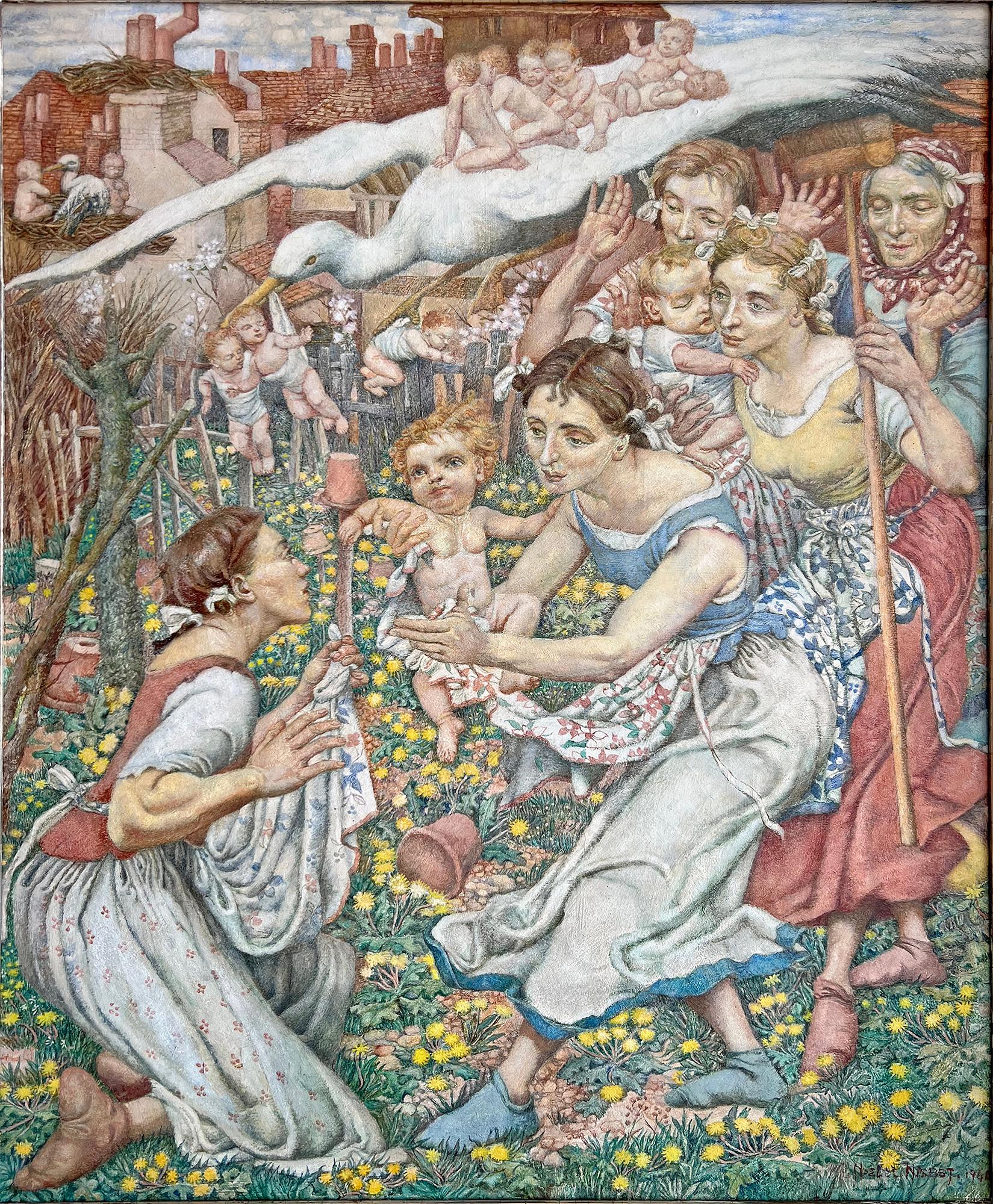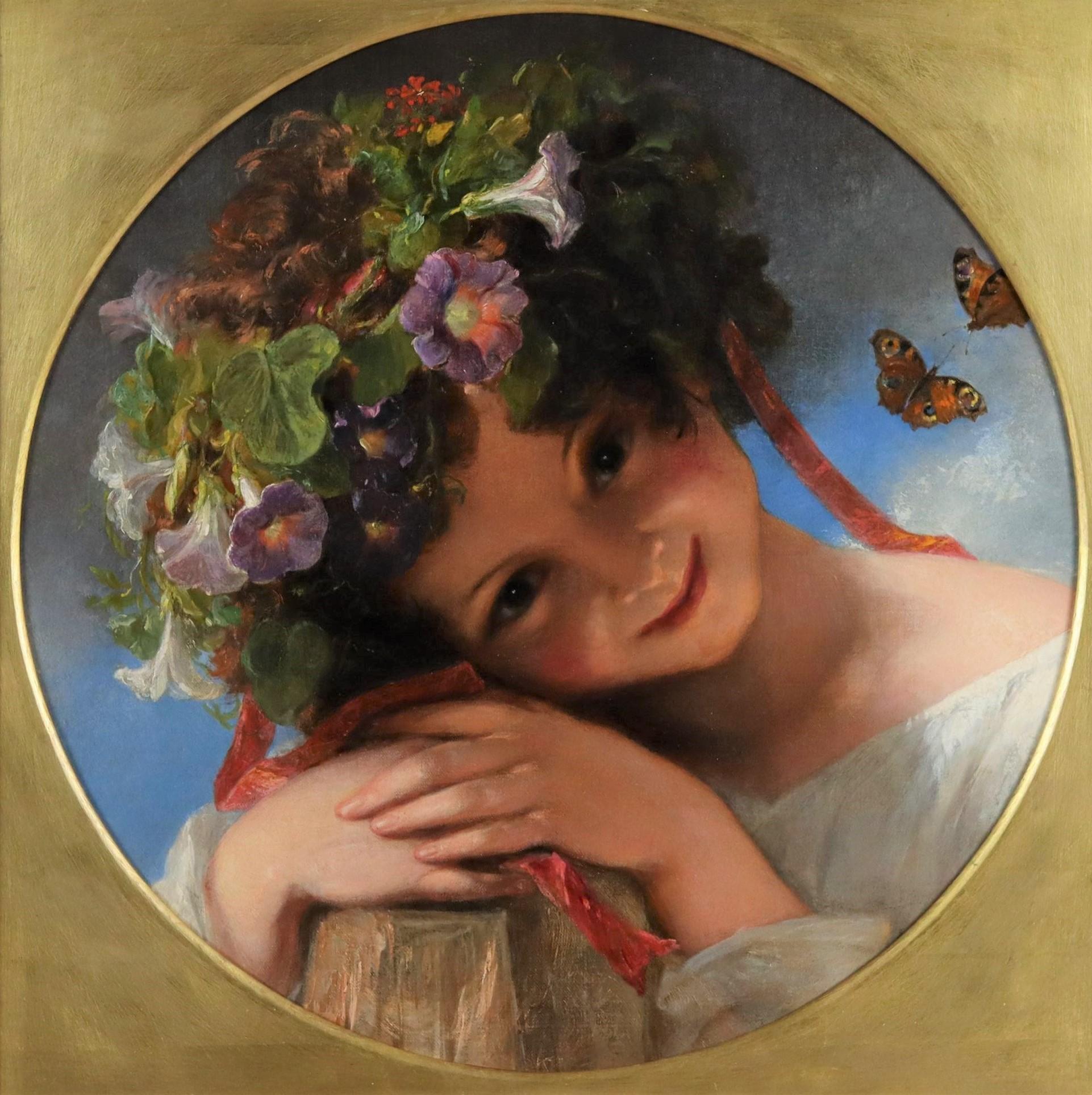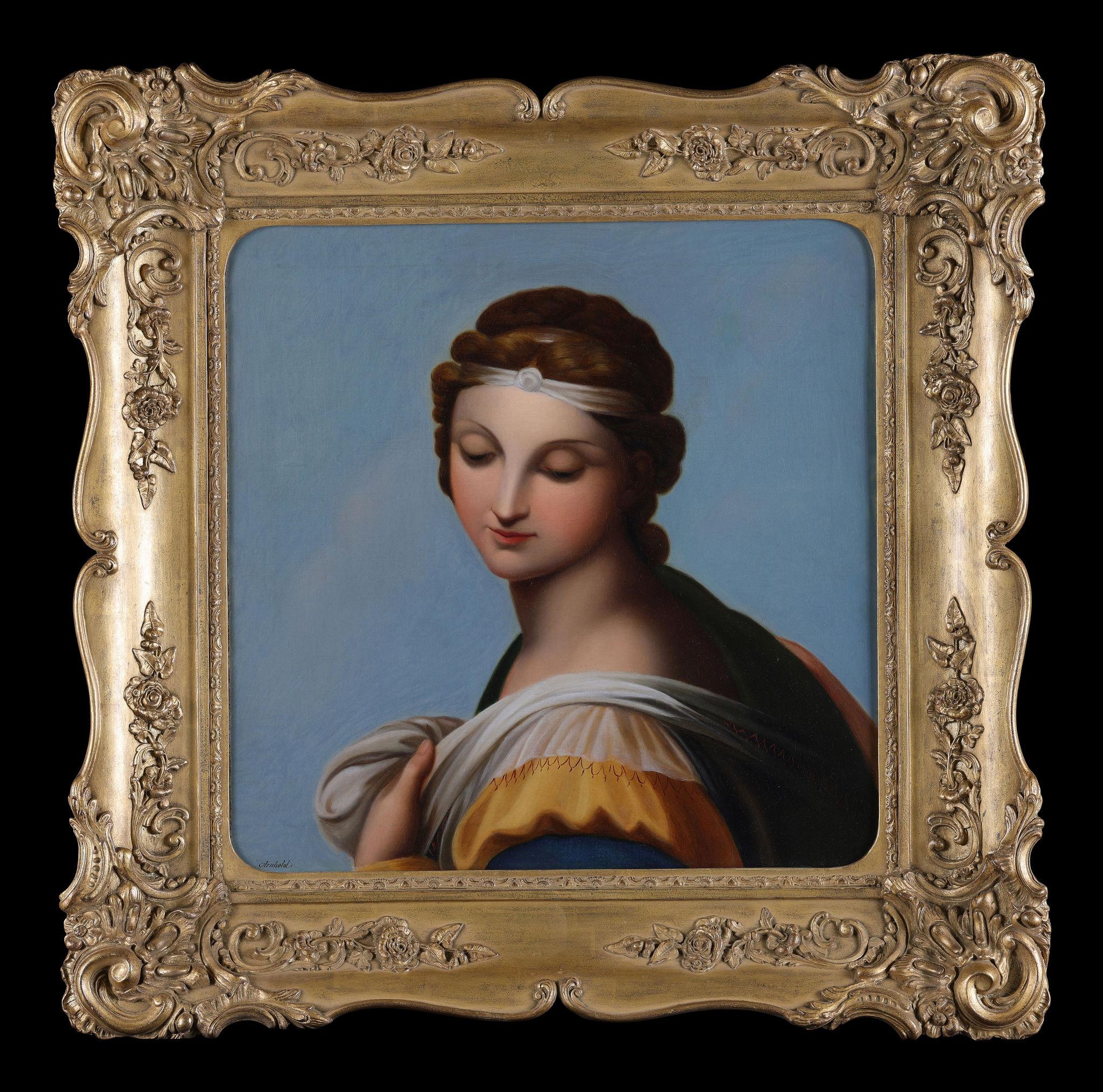Items Similar to Self Portrait, 19th Century Pre-Raphaelite Oil Painting
Want more images or videos?
Request additional images or videos from the seller
1 of 3
19th century British SchoolSelf Portrait, 19th Century Pre-Raphaelite Oil Painting
About the Item
Oil on canvas
Image size: 9 1/4 x 7 inches (23.5 x 18 cm)
Original pierced gilt frame
This wonderful Pre-Raphaelite self-portrait contributes to the artistic tradition of representing one's self through visual means, a tradition that stretches back to the time of Ancient Egypt.
Throughout the course of art history self-portraiture has remained a tried and true practice among leading artists. Self portraits can provide a fascinating glimpse into an artist's personality, professional ambition and their social success.
This self portrait is an exercise in technique as well as personal self-examination. The artist's soft eyes and relaxed body language welcome us into the scene we are presented with. The exquisite detail that the artist has achieved with the oil paint is captivating - look at the individually crafted hairs that punctuate the man's chin. This detail adds to the atmosphere of the scene, as does the warm lighting with which the artist has been lit. The light illuminates the artist's face as he turns to the viewer while creating a shadow across his jawline. A glowing aura is also formed around his figure, allowing the artist to exude a stage-like presence.
- Creator:19th century British School
- Dimensions:Height: 9.25 in (23.5 cm)Width: 7 in (17.78 cm)
- More Editions & Sizes:1 of 1Price: $7,002
- Medium:
- Movement & Style:
- Period:
- Condition:
- Gallery Location:London, GB
- Reference Number:1stDibs: LU52410975462
About the Seller
5.0
Vetted Seller
These experienced sellers undergo a comprehensive evaluation by our team of in-house experts.
Established in 2007
1stDibs seller since 2014
64 sales on 1stDibs
Typical response time: 2 hours
- ShippingRetrieving quote...Ships From: London, United Kingdom
- Return PolicyA return for this item may be initiated within 14 days of delivery.
More From This SellerView All
- Portrait of a Young Woman, 19th Century Pre-Raphaelite Oil on CanvasLocated in London, GBLouisa Starr 1845 - 1909 Portrait of a Young Woman Oil on canvas, monogrammed Image size: 8 ½ x 6 ¼ inches (22 x 16 cm) Pre-Raphaelite style frame Provenance Family Estate Christies Private Estate This rare beautiful portrait is clearly influenced by the Pre-Raphaelites, who were friends of Louisa Starr. The Pre-Raphaelites often included symbolic elements in their work, and the background of ivy in this painting, symbolising everlasting life, is a reference to that. This is an early work by Starr as she uses her monogram of a letter L with a star, which can be seen bottom right. The photograph below shows the painting in her studio, top left. The Artist Louisa Starr was born in Liverpool of American descent. Starr attended Heatherley's Art School. During this period artistic training was dominated by the Royal Academy Schools, which gave students a rigorous grounding in life-drawing and painting, presided over by Frederick Leighton and staffed by some of the leading artists of the time. Competition to enter the RA schools was very great, and at sixteen Louisa Starr became the youngest student ever to attend, being one of two students selected out of thirty eight entrants. The fact that she was a woman is very significant. She signed her work 'L Starr' so that her gender was not apparent, and when her identity became known, she was told that it was not permitted by the constitution to admit female students. (Women had attended the RA Schools before but not in any great number and not for some time). When she asked to see the clause, it could not be found, and they ended up admitting six women students so that they could chaperone each other. She had an outstanding career as a student, winning a Silver medal for the best copy of Murillo's 'Beggars' in 1865 - which was the first medal ever awarded by the RA to a woman, and a Gold medal for the most successful historical painting in 1867. She met her future husband, Enrico Canziani, an Italian cousin, whilst visiting relatives in Italy. Her independent outlook and progressive thinking were somewhat at odds with traditional Italian village life, but Enrico understood and encouraged her work by setting up a studio space and helping to find local models for her to paint. He was a civil engineer, who had built a sugar refinery in Italy and established paper-mills and chemical product factories. They married in Dover in 1882, when Starr was thirty seven, and her attitude to life and work continued to be assertive and uncompromising. For example, she removed the 'obey' from the marriage service, and it was decided that she would continue to live and work in England, and Enrico would be the one to move. He settled in England, but as much of his business was in Italy he continued to visit at least three times a year. Their daughter Estella was born in 1887. She became a portrait and landscape painter, an interior decorator and a travel writer and folklorist. Estella reports that her mother dreamed of an ideal house and recognised it while driving in Kensington Gardens, seeing a board up advertising it to let. She telegraphed to her husband to come back from Paris and they secured the property just five minutes ahead of a gentleman who was also waiting for the office to open. Estella was born there two years later. The address was 3 Palace Green, Kensington. Louisa was good friends with many of the prominent artists of the day including Frederick Lord Leighton, Val Princep and his family who lived next door to Leighton as well as G F Watts...Category
1850s Pre-Raphaelite Portrait Paintings
MaterialsOil
- Portrait of a GentlemanLocated in London, GBOil on canvas Image size: 17 x 23 1/2 inches (43 x 60 cm) Contemporary William Kent hand made frameCategory
18th Century Portrait Paintings
MaterialsCanvas, Oil
- Portrait of Herbert Fisher, Mid-19th Century Oil Painting, Original Watts FrameBy George Frederic WattsLocated in London, GBOil on canvas c.1855 - 1860 Image size: 19 x 14 inches (48.25 x 37.25 cm) Original Watts frame The Sitter Herbert William Fisher (1826 - 1903) was a British historian, best known for his 'Considerations on the Origin of the American War' (1865). Fisher was tutor to the future King Edward VII, and served as Private Secretary to the 5th Duke of Newcastle. in 1863 he became Private Secretary to the Prince of Wales, his former pupil, before being appointed to the position of Vice-Warden of the Stannaries in 1870. One of his daughters, Adeline, married Ralph Vaughan Williams. George Frederick Watts Watts (1817 - 1904) was a British painter and sculptor associated with the Symbolist movement. He is known to have said 'I paint ideas, not things'. Watts became famous in his lifetime for his allegorical works, such as 'Hope' and 'Love and Life' in which the emotions and aspiration life were intended to be represented in a universal symbolic language. Watts was born in Marylebone in central London on the birthday of George Frederic Handel (after whom he was named), to the second wife of a poor piano-maker. He showed artistic promise very early, learning sculpture from the age of 10 with William Behnes, starting to study devotedly the Elgin Marbles (later writing "It was from them alone that I learned") and then enrolling as a student at the Royal Academy Schools at the age of 18. He first exhibited at the Academy in 1837, with a picture of "The Wounded Heron" and two portraits, but his attendance at the Academy was short-lived, and his further art education was confined to personal experiment and endeavour, guided by a constant appeal to the standard of ancient Greek sculpture. He also began his portraiture career, receiving patronage from his close contemporary Alexander Constantine Ionides, who later came to be a close friend. In 1849 the first two of the allegorical compositions which form the most characteristic of the artist's productions were exhibited—"Life's Illusions," an elaborate presentment of the vanity of human desires, and "The people that sat in darkness," turning eagerly towards the growing dawn. In 1850 he first gave public expression to his intense longing to improve the condition of humanity in the picture of "The Good Samaritan" bending over the wounded traveller; this, as recorded in the catalogue of the Royal Academy, was "painted as an expression of the artist's admiration and respect for the noble philanthropy of Thomas Wright, of Manchester," and to that city he presented the work. From the late 1840s onward he painted many portraits in France and England, some of which are described below. Notable pictures of the same period are “Sir Galahad...Category
1850s Victorian Portrait Paintings
MaterialsCanvas, Oil
- Portrait of Thomas Cooper Gotch, 19th Century Oil PaintingLocated in London, GBOil on canvas on board Image size: 7 x 5¼ inches (18 x 13.5 cm) Framed This portrait of Thomas Gotch is by his lifelong friend and confidante, Jane Ross, whom he met at Heatherley’s...Category
1880s English School Portrait Paintings
MaterialsCanvas, Oil
- Portrait of a Lady, 17th Century Flemish Oil Old MastersBy Jacob HuysmansLocated in London, GBJacob Huysmans Flemish 1633 - 1696 Portrait of a Lady Oil on canvas Image size: 49 x 40 ¼ inches Gilt frame Huysmans was born in Antwerp and came to England during the reign of Charles II where he became one of the fashionable painters of the court.. The diarist Samual Pepys noted the artist as capable of a more exact likeness than Lely. Certainly the diarist records that by August 1664 in the circle of Queen Catherine...Category
17th Century Old Masters Portrait Paintings
MaterialsCanvas, Oil, Acrylic
- Portrait of Conrad Friedrich Hurlebusch, Early 18th Century Oil PaintingBy Dominicus van der SmissenLocated in London, GBDominicus van der Smissen Early 18th Century Portrait of Conrad Friedrich Hurlebusch Oil on canvas Image size: 20½ x 16¼ inches Period gilt frame This is a portrait of Conrad Friedrich Hurlebusch, composer, Kapellmeister and organist, whom Van der Smissen most probably portrayed during his stay in Hamburg, Brunswick or Amsterdam. The identification is based on the reproduction of the portrait which was engraved by Pieter Anthony Wakkerdak (1740- 1774). Van der Smissen has reduced the face of the sitters to an egg-shaped oval in three-quarter view, applying diminution to one half of the figure’s torso, which is farther away from the viewer. This partial side view, with the head turned to look at the viewer over the shoulder, creates spatial depth and brings the figure to life by avoiding the stiffness of a frontal depiction. Because the artist chose to highlight the figure from above, a distinct shadow is cast under the tip of the nose, in the shape of a triangle. This is an often recurring and almost ‘signature’-like feature in Van der Smissen’s oeuvre. Hurlebusch's garments are of a very high quality and serve to reflect the sitter’s wealth, status and elegance. During this period, gentlemen often shaved their heads in order to facilitate the wearing of a wig, which wouldbe worn with a suit. Here Hurlebusch has been depicted in a luxurious turban-like cap lined with lynx fur, a highly fashionable and expensive material at the time. Over his shirt, he wears a velvet fur-lined gown adorned with decorative clasps fashioned from silver braid. The elegant informality of his appearance can be seen in his unbuttoned shirt and the unfastened black ribbon hanging from his button hole, which has been artfully arranged into a fluttering drape by the portraitist. The Sitter Hurlebusch was born in Brunswick, Germany. He received the first instructions in his field from his father Heinrich Lorenz Hurlebusch, who was also a musician. As an organ virtuoso, he toured Europe, visiting Vienna, Munich and Italy. From 1723 to 1725 he was Kapellmeister in Stockholm; later he became Kapellmeister in Bayreuth and Brunswick, and lived in Hamburg from 1727 to 1742, where he had contact with fellow composers Johann Mattheson and Georg Philipp Telemann. He made his living composing, performing and teaching. In 1735 and 1736, he is believed to have visited Johann Sebastian Bach in Leipzig, who promoted Hurlebusch’s compositions as the local seller...Category
Early 18th Century Old Masters Portrait Paintings
MaterialsCanvas, Oil
You May Also Like
- Pre-Raphaelite Style Painting of Mothers and Babies in WWIILocated in Miami, FLBabies are falling from the sky and not bombs. British female artist and illustrator Noel Laura Nisbet makes a passionate twist to the reality of En...Category
1940s Pre-Raphaelite Figurative Paintings
MaterialsCanvas, Tempera, Mixed Media, Oil
- Portrait of an Enchanting Young Girl Wearing a Garland of Morning Glory FlowersBy James HollandLocated in West Sussex, GBAttributed to James Holland (1799 -1870) and William Henry Hunt (1790-1864) A Portrait of a Young Girl Wearing a Garland of Morning Glory Flowers Oil on canvas: 17 ½ x 18 in. Frame: 23 ½ x 24 in. Circa 1820 An enchanting head and shoulders portrait of a young girl wearing a white shift...Category
Early 19th Century Pre-Raphaelite Portrait Paintings
MaterialsOil
- Melancholic Sappho - Large 19th Century Pre-Raphalite Oil Painting Greek GoddessLocated in Gerrards Cross, GB‘Melancholic Sappho’ by Arthur Hill RBA (1841-1908). The painting – which depicts the celebrated poet of Ancient Greece appealing to the Goddess Aphrodite, with the Parthenon on the...Category
1870s Pre-Raphaelite Portrait Paintings
MaterialsOil
- Melancholic Sappho - 19th Century Pre-Raphalite Exhib Oil Painting Greek GoddessLocated in Gerrards Cross, GB‘Melancholic Sappho’ by Arthur Hill RBA (1841-1908). The painting – which depicts the celebrated poet of Ancient Greece appealing to the Goddess Aphrodite, with the Parthenon on the...Category
1870s Pre-Raphaelite Portrait Paintings
MaterialsOil
- Guinevere - 19th Century Pre-Raphaelite Oil Painting of King Arthur Queen LegendLocated in Gerrards Cross, GB‘Guinevere’ by Norman Prescott-Davies R.B.A, R.C.A. (1861-1915). The painting – which depicts an English mediaeval portrait of Queen Guinevere at Amesbury Priory contemplating her lo...Category
Late 19th Century Pre-Raphaelite Portrait Paintings
MaterialsOil
- A Pre-Raphaelite BeautyLocated in St. Albans, GBA wonderful painting of a beautiful woman in the style of the Pre-Raphaelites. It is signed Arnhold. It is in very condition and in the original frame. Picture Size: 21 x 21" (51 ...Category
1850s Pre-Raphaelite Portrait Paintings
MaterialsOil
Recently Viewed
View AllMore Ways To Browse
18th Or 19th Century Etchings
Antique Century
Centuries Antique
Century Antique
Century 9
Art Of The 19th Century
19th Century Scene
Portrait Of Self
British 19th
Artist Self Portrait
19th Century Man
British School Painting
Antique Oil Well
Oil On Canvas 19th Century Artist
British History
Oil Painting 18 Century
19th Century British Art
19th Century Original Oil Paintings


